
Customer-centric digital transformation Making customer success integral to the new organization
10 minute read
06 September 2019
How can an organization keep customers—rather than technology—at the center of a transformation effort? This article, fifth in a series, explores the benefits of developing a proactive customer success capability.
The customer success function and mindset
Yes, technological advances are driving fundamental market shifts and a new wave of digital-driven disruption.1 But customers—increasingly seeking always-on, performance-based, and integrated solutions—may be an even greater catalyst.2
Learn more
Explore the Digital industrial transformation collection
Explore more on Industry 4.0
Subscribe to receive related content from Deloitte Insights
Download the Deloitte Insights and Dow Jones app
Indeed, customer expectations and demands are creating critical challenges—as well as opportunities—for employees across sales, services, support, and product functions. To successfully ride this wave of change, companies need to continuously evaluate how digital disruption is changing customer behavior, rethink their customer engagement model to leverage disruptive technologies, and redesign employees’ roles to form customer success (CS) capability that maximizes value for customers and enables an enhanced experience for them.
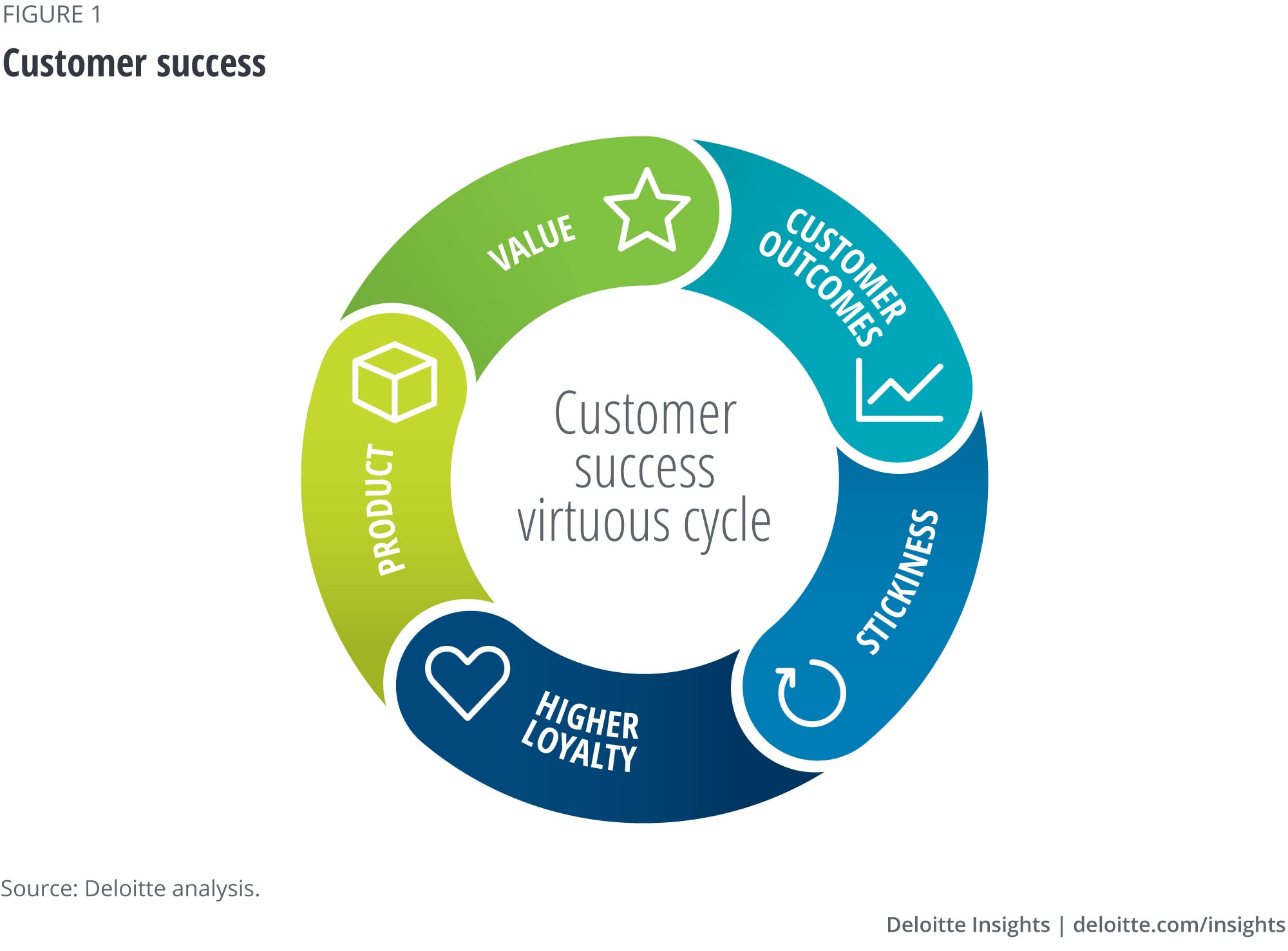
Customer success is the proactive orchestration of a customer’s journey that maximizes the value for the end customer across the life cycle.
In short, we believe that organizations must make customers central to digital transformation and activate the virtuous cycle. Figure 2 illustrates how building a customer-centric organization ties into our overall digital transformation framework.
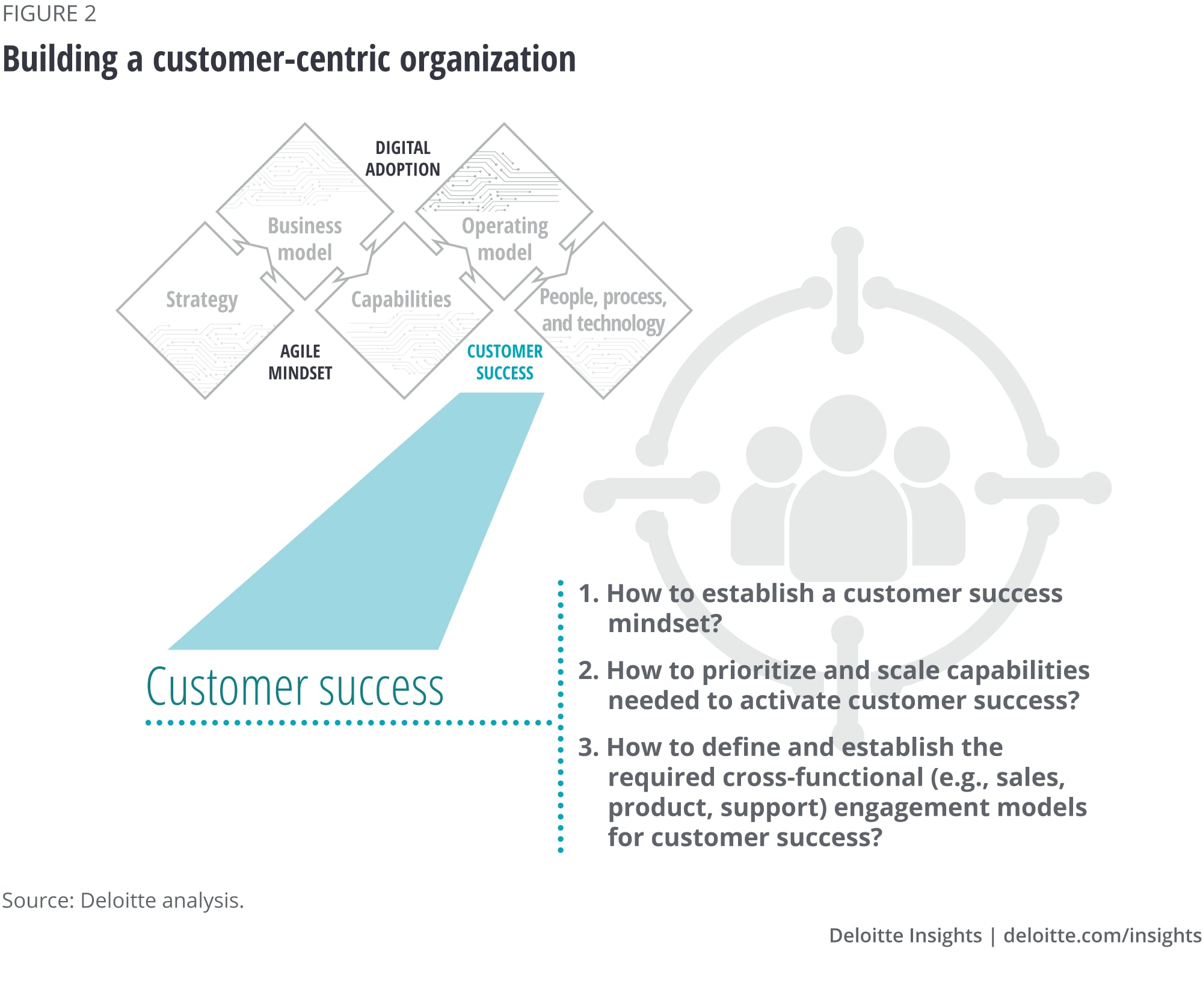
From churn reduction to value generation
The ever-changing technology landscape—currently shaped by technologies such as cloud computing, anything-as-a-service (XaaS), and the Internet of Things (including industrial IoT)—has solidified the need for businesses to adopt a customer-in mindset, shifting focus from selling a product to nourishing a customer relationship: understanding expectations and maximizing customer value from offerings.3
B2B companies that invest in a CS function are looking for a range of gains, including lower cost to serve, higher willingness to spend, increased loyalty, and brand advocacy. Unsurprisingly, good customer success capability execution brings tangible benefits:
- Spend. Sixty-two percent of B2B customers have purchased more from a company after a good customer service experience.4
- Tenure. After building a relationship, customer spend grows alongside trust. Eventually, loyal customers spend 67 percent more than new ones.5 Over the course of a year, experience-driven businesses grew revenue 1.4 times faster and increased customer lifetime value 1.6 times more than other companies.6
- Cost of service. Maximizing satisfaction with customer journeys has the potential of lowering the cost of serving B2B customers by as much as 20 percent.7
- Referrals. After a positive experience, 83 percent of customers would be happy to provide a referral if asked.8 Questions such as, “How likely are you to refer a friend or colleague?” can help customer service managers identify which customers to ask for referrals.
Beyond selling
In the cloud era, the CS function has evolved alongside B2B business models (figure 3), originating with the industry’s movement from businesses dependent on reducing churn to XaaS companies with delivery and monetization models that focus on customer retention and value creation.9

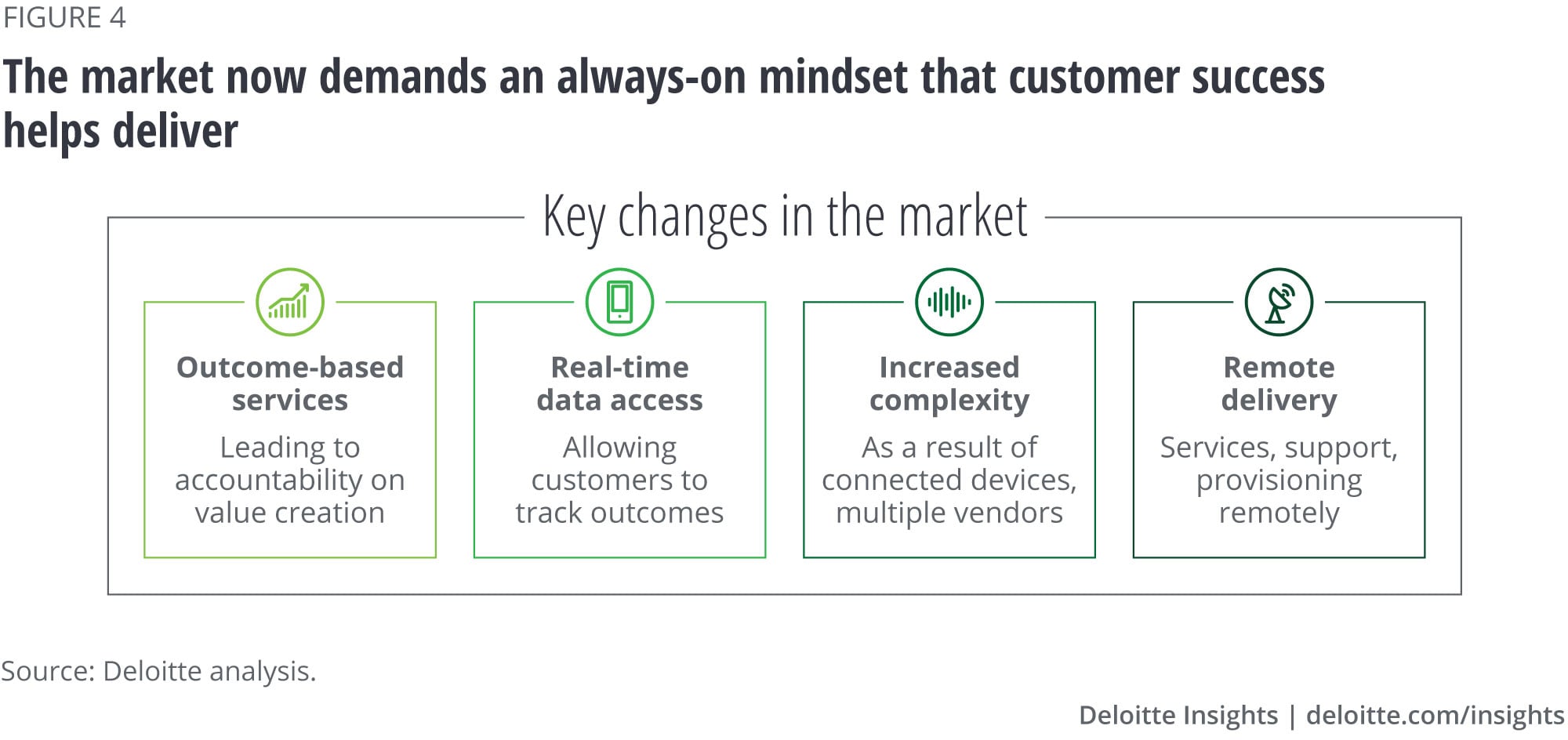
The proliferation of enterprise IoT, XaaS solutions, and data-generating connected devices makes outcome-focused CS management a realistic opportunity for B2B companies—especially those pursuing a customer-centric digital transformation to help increase “stickiness” and customer loyalty.
Going forward, B2B customers will increasingly expect companies to deliver a seamless experience with both human and digital touchpoints. While human interactions largely drive current touchpoints, future touchpoints will increasingly skew toward digital and provide a real-time customer experience that is contextualized, personalized, and data- and usage-driven. Human interactions, meanwhile, will likely focus on orchestrating the ecosystem, co-creating value with the customer, and helping the customer versus selling.10
To create a truly differentiated CS function, therefore, B2B companies should look to develop a human-plus-digital engagement model that focuses on helping customers recognize and maximize the value of their purchased products and services.
Approach to customer-centric transformation
As per our analysis, the companies leading in customer success11 have common elements in their approach. Their leaders usually design an end-to-end CS capability and discipline that drives toward customer-centricity.
The transformation begins with defining the north star or the organization’s CS vision.12 Based on this vision, leaders define the capabilities and operating model required to deliver the CS targets envisioned.13 These capabilities are usually defined at three levels: core (foundational capabilities owned and managed solely by the CS function), shared (capabilities shared between CS team and internal business functions), and enterprise (capabilities owned and managed at an enterprise level, prerequisites for the CS team to function successfully). Additionally, leaders often aim to design the organization’s governance operating model to enable collaboration between CS and internal functions such as product engineering, sales, marketing, and support.
Following the capability and operating model establishment, the organization employs strong KPIs, metrics, and systems to ensure successful transformation. A key step is driving a CS mindset across the enterprise, often requiring a definitive change in culture in alignment with the enterprise’s specific situational factors. This can be the most difficult—and most rewarding—part of the journey. Companies able to focus and execute on this can move to having customer-centric C-suite conversations, making it part of the organizational DNA.
The conversation can shift from, “What are our profit and revenue this quarter?” to, “How are we providing value to customers? What experiences are they enjoying with us? Are they getting value from our products/offerings?”
Figure 5 illustrates the perspective a company can take to measure the value generated (qualitative and quantitative) by CS transformation in real time—and to understand the expected outcomes. Creating and delivering business value starts by clearly articulating performance measures that reflect the customer’s outside-in view of value and the company’s inside-out product view of value and bridging the gap between product performance and usage experience. Measures of customer value (business value, experience value, and performance value) combined with traditional business outcomes-focused metrics (for example, increasing revenue, increasing tenure, lowering costs, and increasing advocacy) can help B2B companies produce a comprehensive value scorecard that identifies both customer and company benefits.

An account health scorecard (based on the measurement framework in figure 5) can offer visibility to enterprise-level performance and alert the respective business function before a customer identifies a problem. This scorecard should:
- Accurately capture the customer’s target objectives, target outcomes, and progress along the value realization plan
- Provide advanced visualization dashboards for users to understand product performance based on usage and business value created
- Track potential/emerging areas of concern and red-flag issues as they emerge
For most organizations that have undergone transformational CS journeys, leaders have carried out a program across three key levels (figure 6). At level one, a strong CS function is established that owns and maintains ongoing customer value realization and is accountable for driving adoption, retention, and expansion.
At level two, a cross-functional engagement model is built in which customer success delivers insights upon which other functions act, aligning their CS outlook with the company’s overall vision.
Finally, at level three, a customer-first mindset is inculcated, making CS a part of the organizational DNA. At this level, CS is considered imperative enough to be given a C-suite seat and be a part of the regular board agenda. The value generated during CS transformation is for not only the customer (value creation) but the company (value capture).
Typically, organizations expend maximum effort to achieve level one maturity but lose focus while driving toward level two. Follow-through is key, since the end goal is a strong customer-centric transformation, and that demands commitment to realize level three maturity. In a recent customer success survey,14 just one-third of respondents said their CS function is led by a C-suite executive, a mere 30 percent report that customer success is considered a strategic priority by the board of directors, and only 26 percent say that official business communications regularly mention customer success.
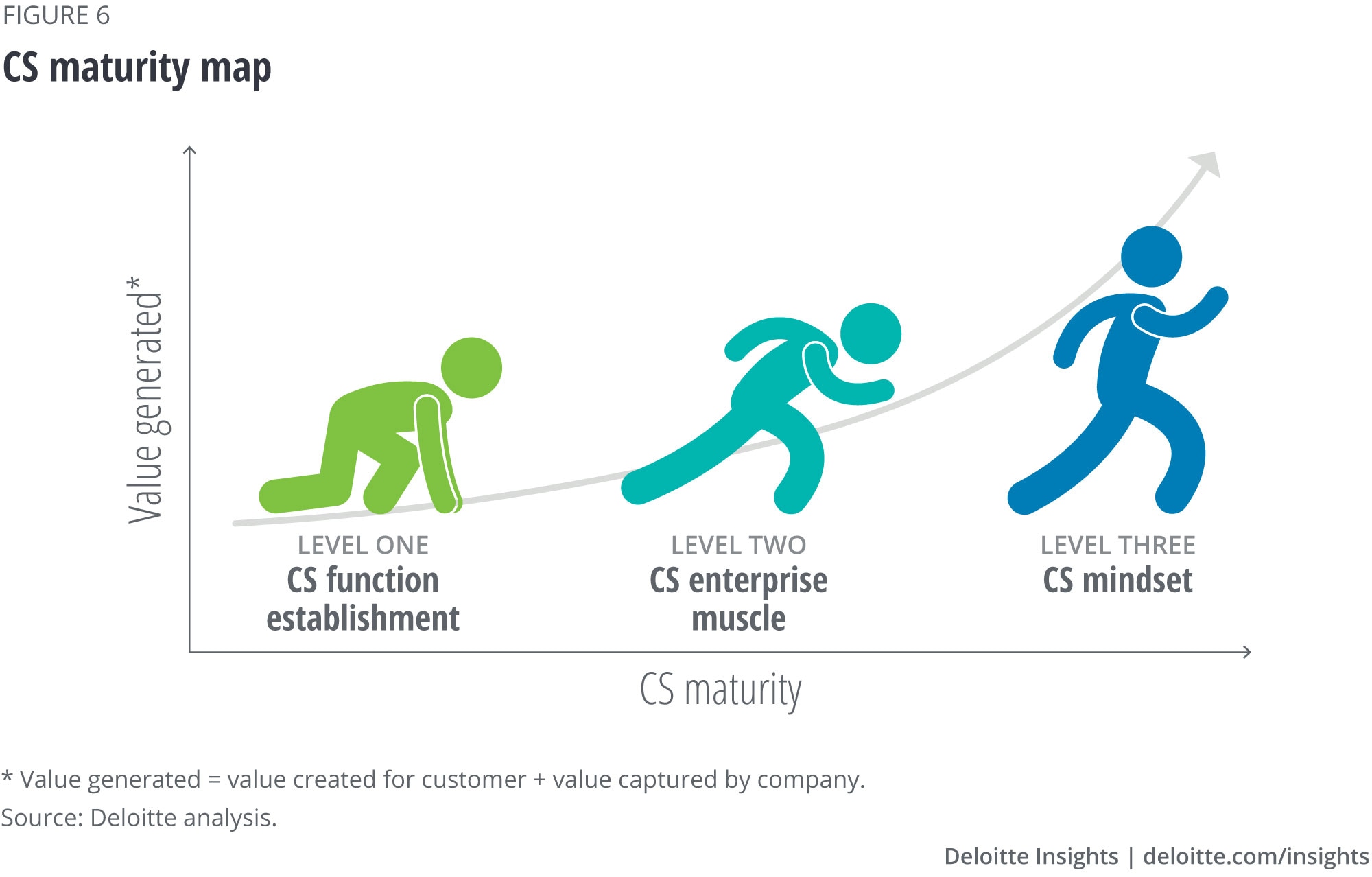
Successful CS transformation journeys
The following examples showcase successful customer-centric digital transformation and the level of CS maturity attained by multiple companies.
A leading software company—a long-term client—faced challenges with customer services and found multiple red flags and isolated efforts, leading to a low net promoter score (NPS).15 Also, with business models shifting to as-a-service, competitors were strengthening their market position and building scale.16
To regain lost ground, company leaders began a transformation journey by defining a vision around proactiveness, distinctive experience, and maximizing value realization. The company developed capabilities such as investment in product feedback loop, health monitoring, and defined new roles such as CS manager and solution adviser. To ensure lasting impact, managers designed customer health scorecards and deployed a CS platform. The company has now included customer success as part of the C-suite agenda and has established the function under the chief customer officer, reporting to the president.
The company realized multiple outstanding outcomes from this multiyear transformation: Stock price more than doubled, revenues increased by 20 percent, NPS and customer satisfaction CSAT scores increased by 7–12 points, and new product development improved by 20–30 percent. The company also noticed a change in customer experience, as the number of direct customer interactions shrunk and became more focused. With information flowing faster and more accurately, customer interaction speed and friction also increased. The CS group shared educational material with customers, describing potential usages of software features, and the company assigned each customer an advocate to help them realize more business value from products. Customers saw a dramatic shift in time to value from their purchased solutions.
As the plan matured and CS function expanded, leaders recognized the need for other companywide changes to be more efficient and effective (figure 7). They aimed to inculcate a CS mindset in the teams, greatly affecting interactions with customers and partners. Core functions became more collaborative and passed on customer insights to each other, enabling the company to build a better cloud-based go-to-market program.
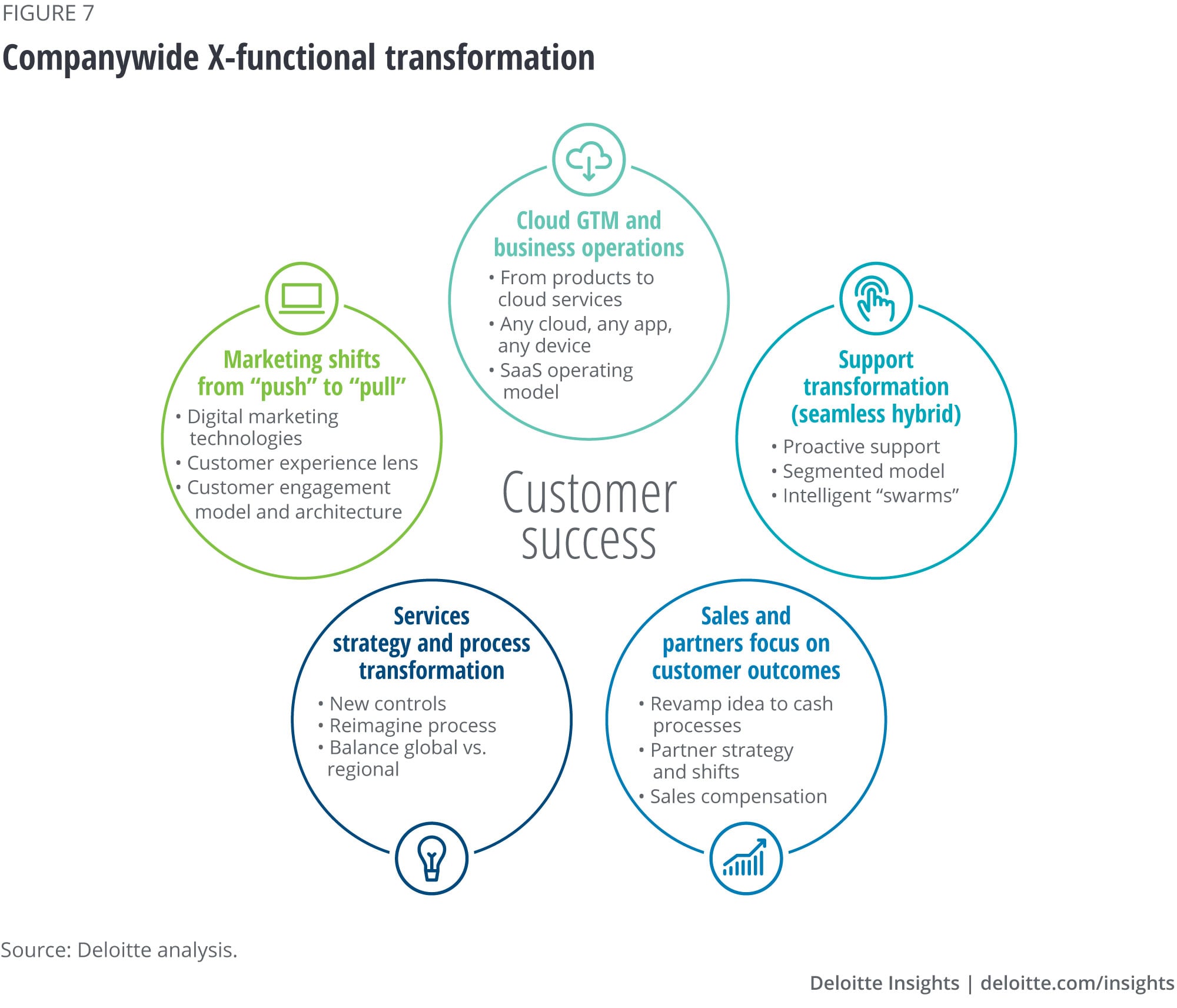
Another company in the hardware and storage space, moving into IoT space, is undergoing a transformation from a legacy hardware storage services company to an XaaS provider. Leaders here see a strong need for a CS model that better amplifies and communicates their products’ true value. The executive committee appointed a CS leadership team to identify the path forward.17
Following a similar framework, the team set its north star on establishing customer success as an organization and adopting a customer-centric mindset. The company planned its transformation into two phases, beginning with a pilot/short-term plan to test customer success manager (CSM) coverage ratios and industry vertical and product mixes, develop best practices for the company’s CSMs, and create an initial iteration of its CS platform with a subset of accounts. In the long term, leaders aim to grow customer success beyond the handful of initial accounts into a full-fledged organization responsible for driving churn rate down and renewal rates up and optimizing the business to enable customers to achieve their business goals and derive maximum value from products and services.
The CS group has been able to bring in new multimillion global orders, close new contracts, and handle problem-solving with quicker turnarounds. Some end customers and account teams are acknowledging their CSMs’ value—for instance, one account team member volunteered, “The CSM is an integral part of our team, and it would significantly hurt our professional-services revenue if we did not have him.” A recent customer success study18 suggested that other companies have seen similar results: Half of the respondents reported 10 percent higher upsell and cross-sell revenues; one-third reported greater than 20 percent uptick in annual recurring revenue after enabling their CS strategy.
Next steps: Function to enterprise muscle to mindset
Undergoing a CS transformation generally requires a B2B company to add differentiated capabilities and processes across the customer life cycle journey—all of which support the goals of maximizing product and service business value, improving satisfaction, and increasing retention. Leaders should begin by reflecting on the importance of customer success as a foundational element in an organization’s journey to customer-centric digital transformation. Three questions to consider:
- How do we ensure that our customers are able to achieve maximum value from the offering they have bought from us?
- How can we capitalize on the value realized by our customers?
- What can we enhance to be in line with a customer-centric digital transformation journey?
To embrace customer-centricity, B2B organizations should ensure that customer success becomes a part of the enterprise muscle. One way to achieve a CS mindset is by putting customer success at the CEO table and on the board agenda. CS teams essentially work cross-functionally, and the organizational capabilities should enable the CS function to have enterprisewide impact. By placing customers at the center of an organization’s strategy, leaders can focus and give direction to an overall digital transformation.






